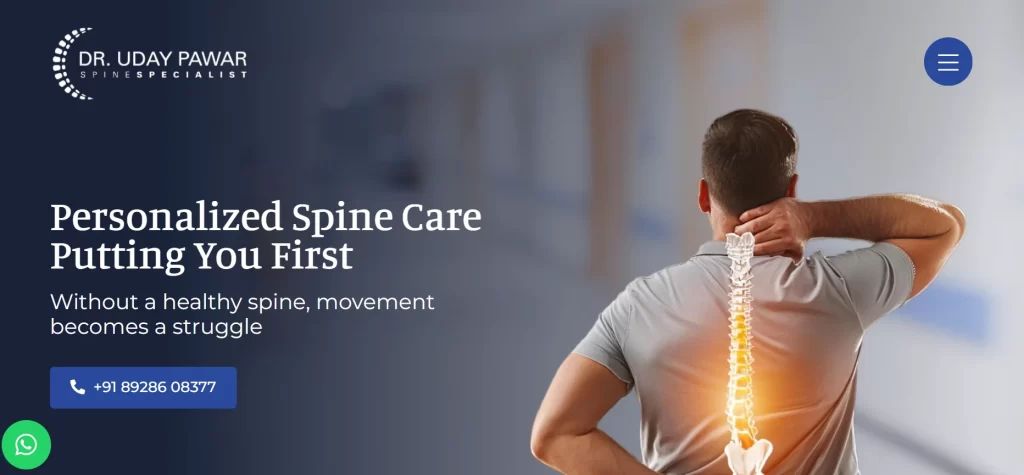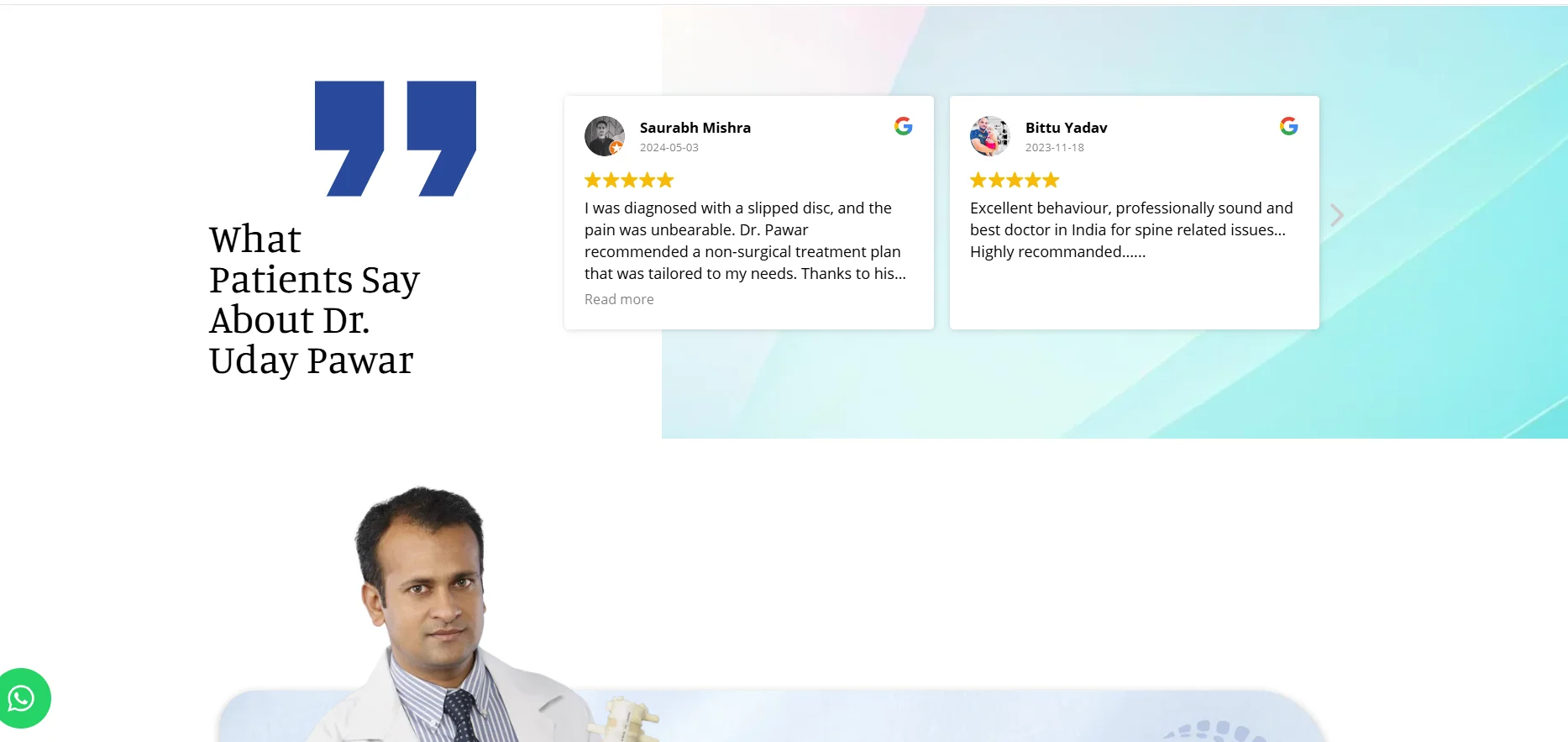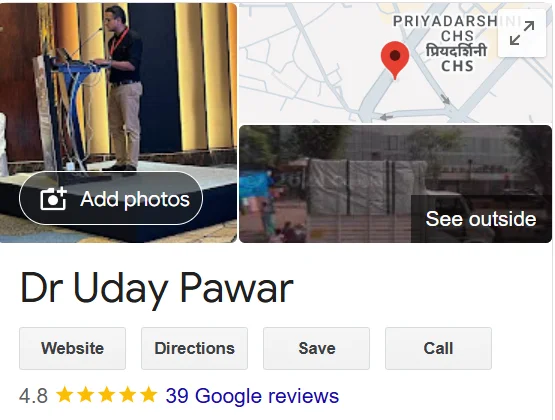Guide to Digital Marketing for Spine Surgeon: Strategies to Grow Your Practice
As spine surgeons, we face challenges that are unlike those of many other healthcare professionals. Our work involves complex procedures, significant risks, and high costs—factors that naturally make patients more cautious.
Unlike common ailments that require a quick prescription or routine check-up, spine conditions often carry life-altering implications. Patients don’t rush into decisions when it comes to spine surgery; they deliberate, seek second or even third opinions, and rely heavily on trust before choosing a surgeon.
Traditionally, referrals from satisfied patients, professional colleagues, and fellow physicians have been the cornerstone of growing a spine practice. While this network remains invaluable, it’s no longer enough in today’s digital age.
Patients are increasingly turning to Google before they turn to anyone else. They search for symptoms, read about treatment options, compare surgeons, and scrutinize online reviews—all before even booking a consultation.
What makes this even more challenging is that spine surgeries are relatively uncommon compared to other medical procedures. The rarity and complexity of these cases mean we’re not just competing for visibility—we’re competing for trust in a field where decisions are made with utmost caution.
This is where a healthcare digital marketing agency steps in—not as a replacement for referrals, but as a powerful complement. It’s about being present where patients are looking, providing them with the information they need, and building a sense of confidence even before they meet you in person.
In this guide, I’ll share how embracing healthcare digital marketing strategies transformed my practice—helping me reach the right patients, strengthen my professional network, and position myself as a trusted expert in spine care.
The Power of Digital Marketing for Spine Surgeons
As spine surgeons, our expertise lies in the operating room, but reaching the patients who need our care the most requires visibility beyond hospital walls. This is where digital marketing becomes a game-changer. Unlike traditional marketing methods, which rely heavily on referrals and word-of-mouth, digital marketing allows you to connect directly with patients who are actively searching for solutions to their spine-related problems.
Imagine a patient experiencing chronic back pain or sciatica. Their first instinct isn’t always to call a doctor—they’re more likely to search online for symptoms, potential causes, and treatment options. This is the moment of opportunity. If your practice appears in their search results, offers credible information, and demonstrates authority in spine care, you’ve already established the first layer of trust before they even step into your clinic.
For me, embracing digital marketing wasn’t just about increasing patient numbers; it was about reaching the right patients—those who genuinely needed specialized spine care. Through strategic online presence, I was able to:
- Educate patients about complex spine conditions and treatment options, reducing fear and misinformation.
- Build trust through patient testimonials, success stories, and educational content.
- Expand my reach beyond traditional referrals, connecting with patients from different regions who found me through online channels.
Digital Marketing for spine surgeons isn’t about aggressive promotion; it’s about positioning yourself as a reliable, knowledgeable expert in spine surgery. It helps bridge the gap between your expertise and the patients searching for it—making your practice more accessible, trustworthy, and visible in today’s digital world.
Building a Strong Foundation: The Website is Your Digital Clinic
In today’s digital era, your website is more than just an online presence—it’s your digital clinic. Just like a well-organized, welcoming physical clinic can put patients at ease, a professional website builds trust even before the first consultation. For spine surgeons, where the stakes are high, and decisions are critical, a website can significantly influence a patient’s choice.

When I revamped my website, I realized it wasn’t just about aesthetics. It needed to:
- Provide clear, concise information about spine conditions and treatment options.
- Highlight my qualifications and experience to build credibility.
- Offer easy navigation so patients can find answers to their concerns without feeling overwhelmed.
An effective website should be mobile-responsive (since most patients search on their phones), fast-loading (because no one likes to wait), and optimized for search engines (so it ranks higher when patients search for terms like “spine surgeon near me”).

What truly made a difference was adding patient testimonials, case studies, and a simple appointment booking feature. This not only enhanced my credibility but also made it easier for patients to take the next step. In essence, your website isn’t just an online brochure—it’s the first impression that could lead to a life-changing consultation.
The Role of Social Media in Patient Engagement
While spine surgery is a highly specialized field, social media has proven to be an invaluable tool for engaging with both current and potential patients. At first, I was skeptical—after all, who would want to follow a spine surgeon on Instagram or LinkedIn? But I soon realized that social media isn’t just about sharing selfies or trending memes; it’s about building connections and educating people in an approachable way.
Through platforms like Instagram, LinkedIn, and Facebook, I was able to:
- Educate patients about common spine conditions, debunk myths, and provide tips on maintaining spinal health.
- Share success stories (with patient consent), which helped build trust and showcase real-life outcomes.
- Engage with the community by answering questions, hosting live Q&A sessions, and providing quick health tips.
One of the most surprising outcomes was the number of patients who said, “I’ve been following your posts for a while, and I finally decided to book an appointment.” Social media allowed me to stay top-of-mind for people who might not need spine surgery today but will remember me when they—or someone they know—do. It’s not about going viral; it’s about creating consistent, meaningful content that resonates with your audience.
Online Reputation Management: The Power of Reviews
When it comes to spine surgery—a field where trust is the foundation of every patient relationship—online reviews can significantly influence a patient’s decision-making process. Patients facing complex spine issues often feel anxious and uncertain, and reading about positive outcomes from others who have walked the same path can provide the reassurance they need.
One of the most impactful tools in managing my online reputation has been Google My Business (GMB). Initially, I underestimated its power, thinking it was just another business listing. However, optimizing my GMB profile transformed how potential patients discovered and perceived my practice.

Here’s how GMB helped my spine practice grow:
- Increased Local Visibility: When someone searched for “spine surgeon near me” or “herniated disc treatment in [city],” my profile appeared prominently on Google Maps and local search results. This helped me attract patients who were actively looking for specialized spine care in their area.
- Trust Through Reviews: Encouraging satisfied patients to leave reviews on my GMB profile created a library of authentic testimonials. Potential patients could read about real experiences, which built trust even before their first consultation.
- Showcasing My Expertise: GMB allowed me to share important information like clinic hours, services offered, contact details, and even photos of my clinic. Regular updates and posts kept my profile active and engaging.
- Direct Patient Engagement: I could respond to reviews—both positive and negative—which showed that I genuinely valued patient feedback. This two-way communication helped build a strong, trustworthy online presence.
One of the most rewarding outcomes was hearing new patients say, “I found you on Google and was impressed by the reviews.” GMB wasn’t just a listing; it became a powerful tool for enhancing credibility, increasing patient inquiries, and fostering long-term trust. For any spine surgeon looking to grow their practice, managing your GMB profile effectively is an essential part of your digital strategy.
Paid Advertising: Reaching the Right Patients Faster
While organic growth through SEO and social media is powerful, there were times when I needed to reach patients quickly and efficiently—especially when launching new services or targeting specific conditions. That’s where paid advertising (like Google Ads and social media ads) played a crucial role.
What I appreciated about paid ads was their precision. Unlike traditional advertising, where you’re casting a wide net and hoping for the best, digital ads allow you to target:
- Specific demographics: Age, location, interests, and even behaviors.
- Keywords: For example, targeting searches like “spine surgeon for herniated disc in [city]” ensured my ads reached people actively looking for my expertise.
- Remarketing: Showing ads to people who previously visited my website but didn’t book an appointment—keeping my practice fresh in their minds.
The results were impressive. Not only did the ads drive more traffic to my website, but they also converted into high-quality patient inquiries. The key isn’t just to run ads—it’s about strategically crafting campaigns that resonate with the right audience, maximizing both visibility and return on investment.
Measuring Success: The Metrics That Matter
In the world of spine surgery, we rely on diagnostic tools, clinical outcomes, and patient feedback to evaluate success. Digital marketing is no different. It’s not enough to just have a website, run ads, or post on social media—you need to measure what’s working and make data-driven decisions to improve your strategy.
When I started focusing on digital marketing, I was introduced to key metrics that provided clear insights into my practice’s online performance:
- Website Traffic: How many people are visiting my website? Where are they coming from—Google searches, social media, or paid ads?
- Conversion Rate: Out of all website visitors, how many are actually booking appointments or making inquiries?
- Bounce Rate: Are people leaving my site quickly without engaging? This helped me identify if my content was relevant and engaging enough.
- Keyword Rankings: Tracking how well my website ranked for important terms like “spine surgeon in [city]” or “herniated disc treatment.”
- Ad Performance: For paid campaigns, I monitored metrics like click-through rates (CTR), cost per click (CPC), and return on investment (ROI) to ensure I was reaching the right audience effectively.
By regularly reviewing these metrics—through tools like Google Analytics and Google Search Console—I gained valuable insights into patient behaviour. I could see which blog topics resonated most, which ads generated the highest-quality leads, and even which days or times people were most likely to book appointments.
The beauty of digital marketing is that everything is measurable. It’s like having a continuous feedback loop that helps you refine your approach and achieve better results over time.
Final Thoughts: Embracing Digital Growth
When I reflect on my digital marketing journey, one thing is clear: it’s not just about attracting more patients—it’s about attracting the right patients. Patients who are informed, engaged, and genuinely seeking the specialized care I provide.
The world of spine surgery is evolving, and so are the ways patients find and choose their healthcare providers. Relying solely on traditional referrals and word-of-mouth, while still important, isn’t enough in today’s digital-first environment. Your online presence is often the first impression you make, even before a patient walks through your clinic door.
In embracing digital marketing for spine practice, GrowthPixel has helped me:
- Expand my reach beyond local referrals, connecting with patients from different regions.
- Educate and empower potential patients through valuable, trustworthy content.
- Build lasting relationships by staying engaged with my audience across platforms.
If there’s one piece of advice I’d offer to fellow spine surgeons, it’s this: don’t view digital marketing as an expense; see it as an investment in your practice’s growth and sustainability.
With the right strategies, tools, and mindset, you can not only grow your practice but also make a meaningful impact on the lives of patients who need your expertise the most.
-
Guide to Digital Marketing for Spine Surgeon: Strategies to Grow Your Practice
-
5 Warning Signs of a Compression Fracture You Must Not Ignore
-
Is Spinal Tuberculosis Curable? Here's What Medical Experts Say
-
Vertebroplasty vs Kyphoplasty: Which Spine Treatment Is Right for You?
-
What is the Difference Between Herniated and Bulging Disc? Diagnosis & Treatment Options

